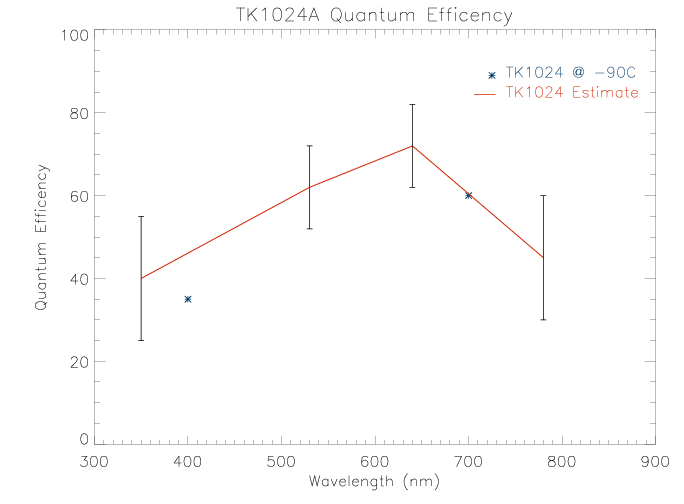
Estimated TK1024 Quantum Efficency:The detector quantum efficency was estimated by making a comparison of virtual simultaneous observations of the same field with both MOSCA and StanCam. The reference quantum efficency for MOSCA was taken from its precommissioning report. Also given in the plot are two values for the expected QE @ -90C, taken from the TK1024 data sheet. Simultaneous data was taken during the technical night 5th October 2004 of the field PG0231+051 and the stars PG0231+051, A and D (Landolt) at a zenith distance: 24 - 25 degrees used. The seeing was 0.5" in R-band on StanCam and images in the four filters UVRI were taken. The flux of the three stars were measured from the "raw" data using aperture radius of 8, 12 and 16 pixels. The background was measured 65 pixels from the star with the width of ten pixels of the annular sky. The actual apertures are different for StanCam and MOSCA (pixel sizes 0.176" and 0.217", respectively). The procedure for reducing the data was to first take the fluxes of each star and aperture were converted to electrons/second assuming gain of 1.68 e-/ADU for StanCam and 1.3e-/ADU for MOSCA. The StanCam fluxes were then multiplied by 1.666 to account for the assumed reflectivity of the CCD-probe mirror being 60% (at all wavelengths). The number was taken from the reflectivity measurements of the mirror using the NOT reflectometer (480nm). Also the difference of the transmission of the filters U (#6 StanCam), I (#13 StanCam), u (#109 MOSCA) and i (#111 MOSCA) were corrected. The correction for the U-filters was 0.68 and 0.89 for I-filter. The R- and V-filters were assumed to be identical. Finally the QE of the MOSCA CCD was estimated from the commissioning report: U 350nm 70%, V 530nm 93%, R 640nm 83% and I 780nm 60%. Most likely the biggest error in these calculations is the estimation of the CCD-probe mirror reflectivity. |
||
|
